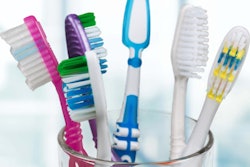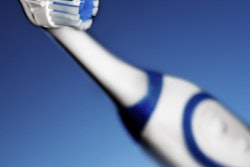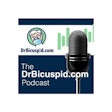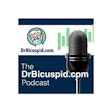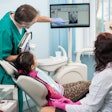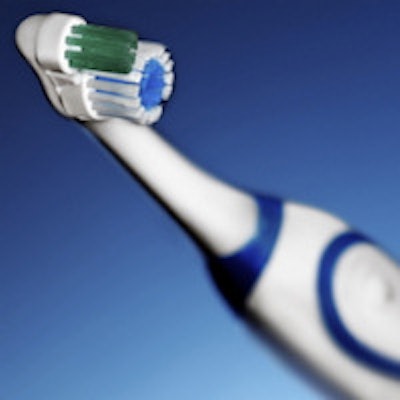
Do patients often bombard you with questions about whether they should use an electronic or manual toothbrush?
With studies comparing the plaque-removal abilities of both toothbrushes producing varied results, it is not always an easy question to answer.
Now a new study that looked at a new power toothbrush developed by Panasonic (EW-DL90) found that while it was more effective than a manual toothbrush at plaque removal, both produced similar papillary bleeding scores after three weeks of brushing (International Journal of Dental Hygiene, April 17, 2014).
The study was funded by Panasonic Foundation of North America and conducted at the New York University (NYU) Bluestone Center for Clinical Research.
The Panasonic EW-DL90 utilizes a sonic vibration movement to produce approximately 28,500 horizontal strokes per minute to remove plaque. The brush features a built-in timer, which pulses once every 30 seconds and twice after two minutes to help ensure that the user complies with the recommended brush time.
Study author Patricia Corby, DDS, the associate director at the Bluestone Center for Clinical Research, told DrBicuspid.com that the research center specializes in conducting clinical trials in many different areas of dental and medical research. Because the researchers are located within an academic institution, they usually select studies that will bring forth new technology and, at the same time, have the potential to impact healthcare.
"Because Panasonic has a long and successful history designing electronics, we became interested in testing their new toothbrush and in how they use their technology for an oral health device," she said.
“The addition of flossing to a power brushing regimen may be able to further improve plaque removal.”
This study was therefore designed to test the efficacy of Panasonic's new power toothbrush by assessing its ability to remove plaque, which is the primary purpose of most toothbrushes, Dr. Corby said.
The study included a total of 84 subjects who were recruited from the NYU Bluestone Center. All the study participants were all at least 18 or older, had at least 20 natural teeth, were in good general and oral health, and at the screening visit had visible plaque accumulation represented by a continuous band of plaque (up to 1 mm) at the cervical margin on at least 30% of all facial tooth surfaces.
They were randomly divided into two groups of 40 each and asked to brush for two minutes twice a day using only their assigned toothbrush and toothpaste.
Individuals assigned to the power brush group were told to brush as indicated using the high-power setting, while those assigned to the manual group were instructed to brush in their customary manner. All subjects were instructed to refrain from using oral hygiene aids such as floss and mouth rinse.
Dr. Corby explained that the researchers' intent was to design a well-controlled clinical trial to assess the power brush's ability to remove plaque without the assistance of coadjutant dental cleaning tools, so they asked participants to refrain from using any interproximal device such as flossing during their study-brushing regimen.
The researchers looked at the change in the subjects' plaque levels after one week of brushing and then after three weeks of brushing, and as a secondary outcome they looked at their papillary bleeding scores at the same intervals.
While both the Panasonic power brush and the manual toothbrush decreased subjects' plaque levels at week three relative to baseline, after one week of treatment, plaque scores in the power brush group were signicantly lower than in the manual group. Plaque scores in the power brush group remained signicantly lower than those in manual group after three weeks.
The manual toothbrush group saw a 21% decrease in plaque after three weeks compared with baseline, while the other group saw a 36% decrease.
Also,while the power brush group had significantly lower gingival inflammation scores after one week, the researchers found no difference between the two groups after three weeks of treatment, the authors noted.
This clinical trial showed that the new power brush consistently demonstrated greater plaque reduction efficacy than a manual toothbrush after one and three weeks of treatment, which is what would be expected after using a power brush, Dr. Corby said.
The findings from the study also showed that both toothbrushes are effective at removing dental plaque, she added. Thus, in the absence of an electric toothbrush, a manual brush will still do a decent job.
At the end of the study, when the researchers looked at the participant's overall gingival health, a significant improvement was found after one week but not after three weeks of treatment.
Although plaque removal was observed after three weeks of treatment, the absence of flossing possibly had a negative impact on preserving long-term gingival health at the interproximal sites, Dr. Corby explained.
"These findings provide clinical evidence to suggest that the addition of flossing to a power brushing regimen may be able to further improve plaque removal interproximally and provide superior long-term gingival health stability," she concluded.
Dr. Corby also revealed an anecdotal finding about the power brush battery life that was not published in this paper. The study started one week before Hurricane Sandy hit New York City, and most of her team's research subjects had no power or electricity for more than 10 days. Prior to product distribution, the research team charged each toothbrush overnight to ensure that subjects got fully charged brushes.
"It is very unusual to find a toothbrush that doesn't require recharging after a few days," she said. "Surprisingly, none of the toothbrushes that we tested died, which would have been a disaster for our study; they remained functional for many days."




